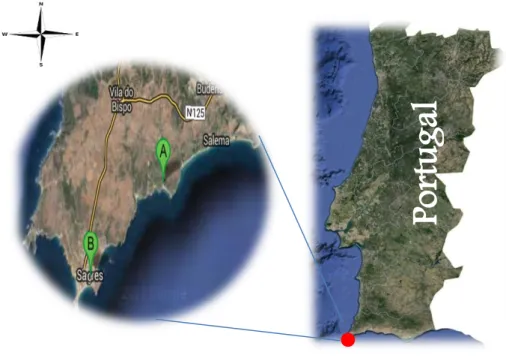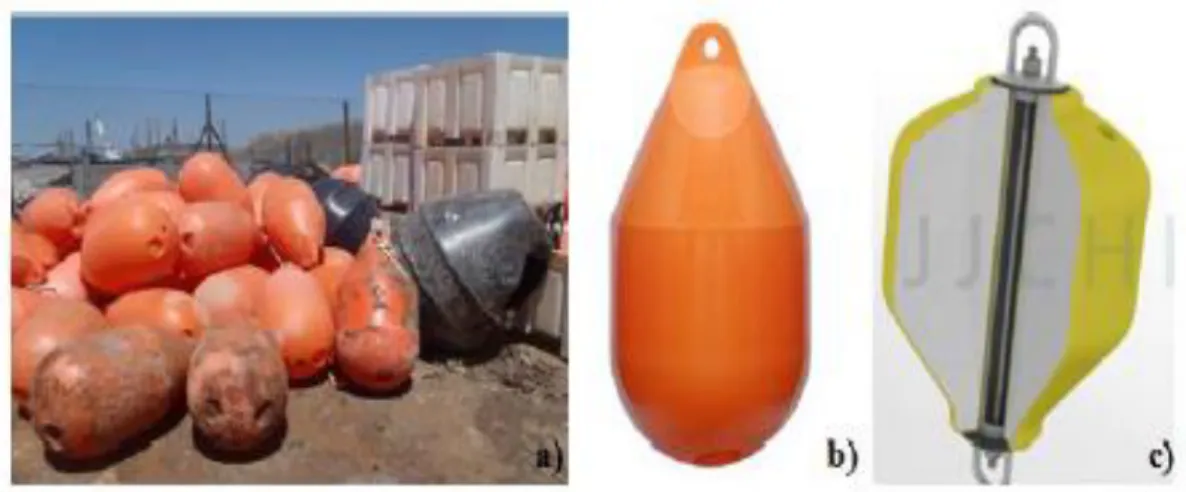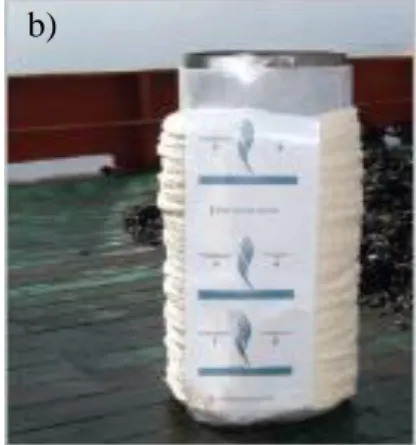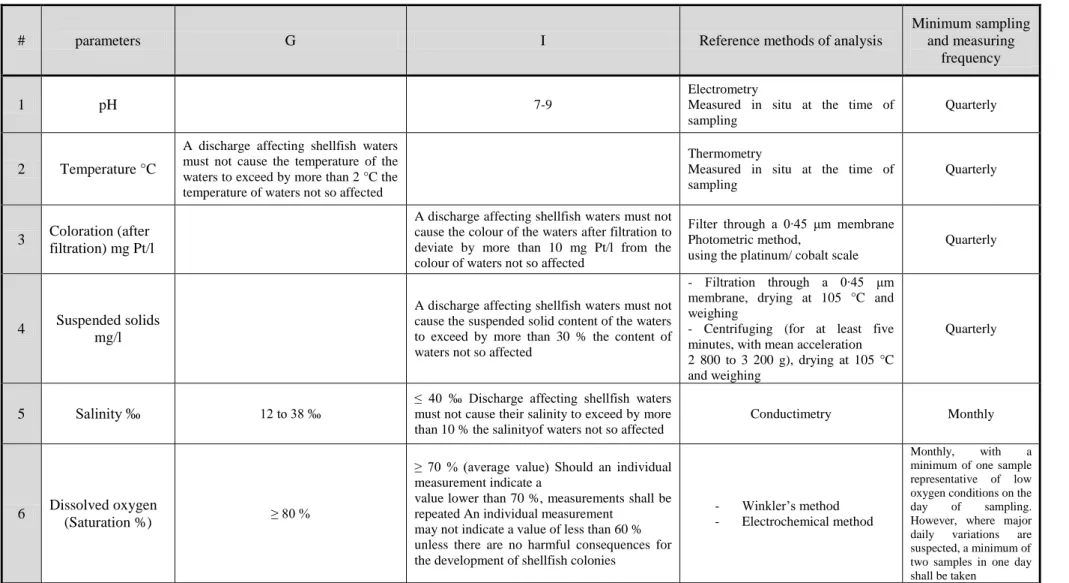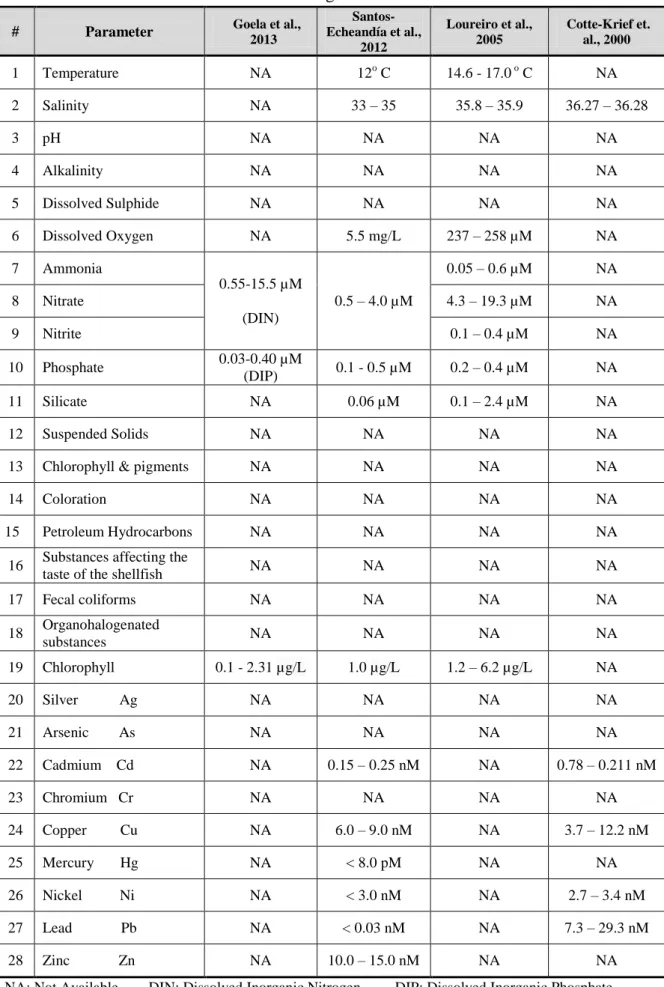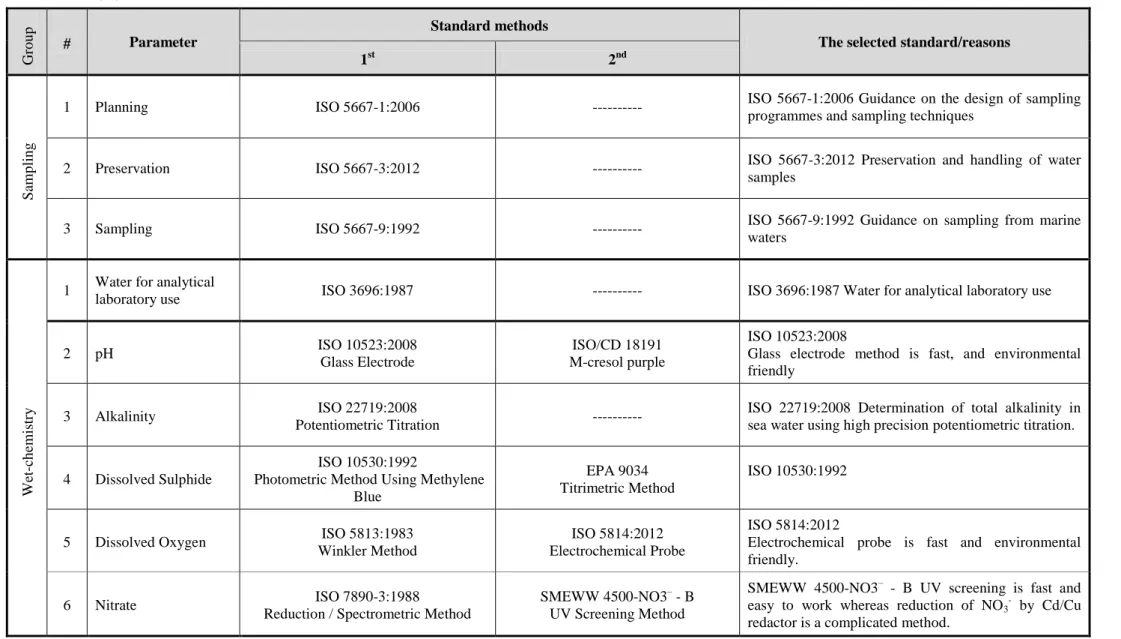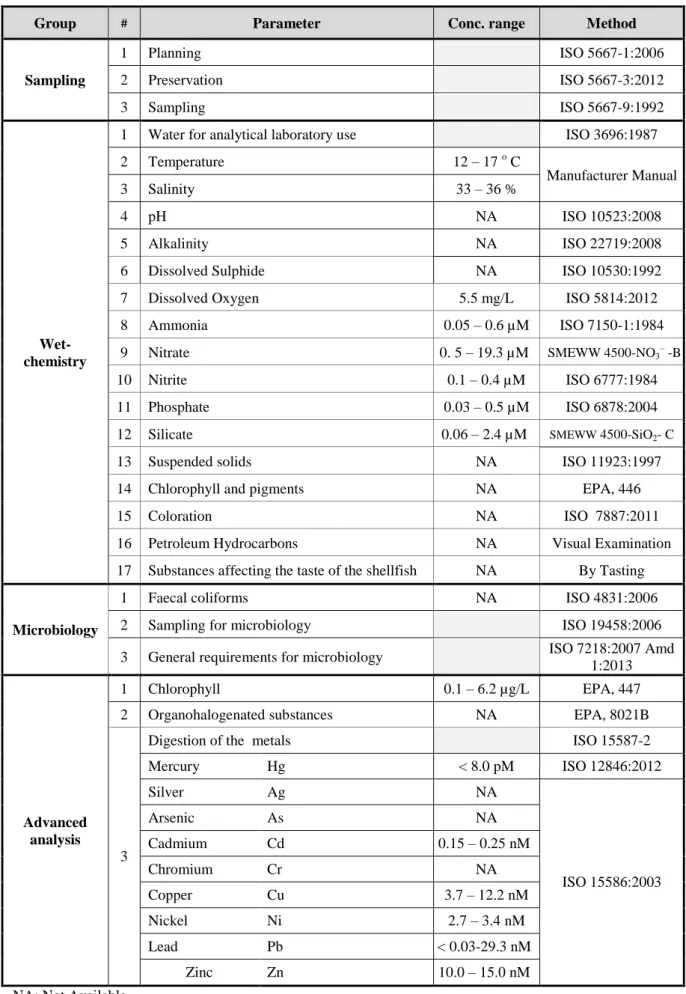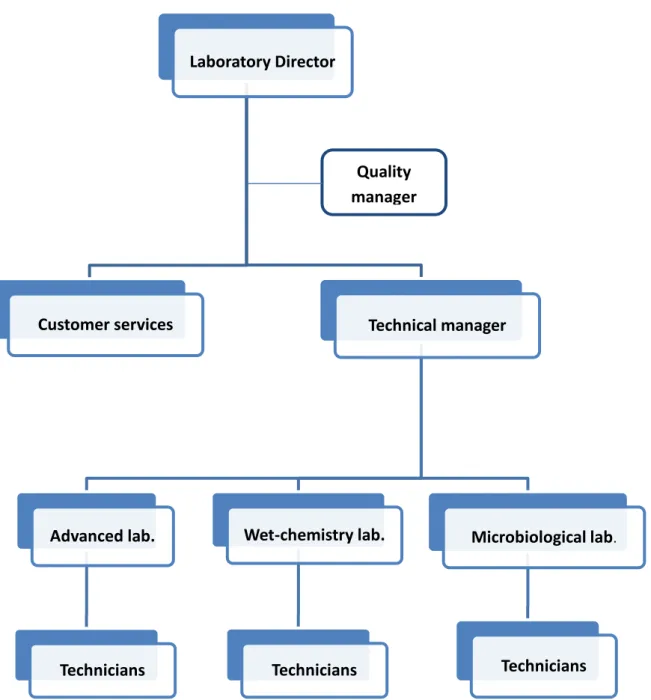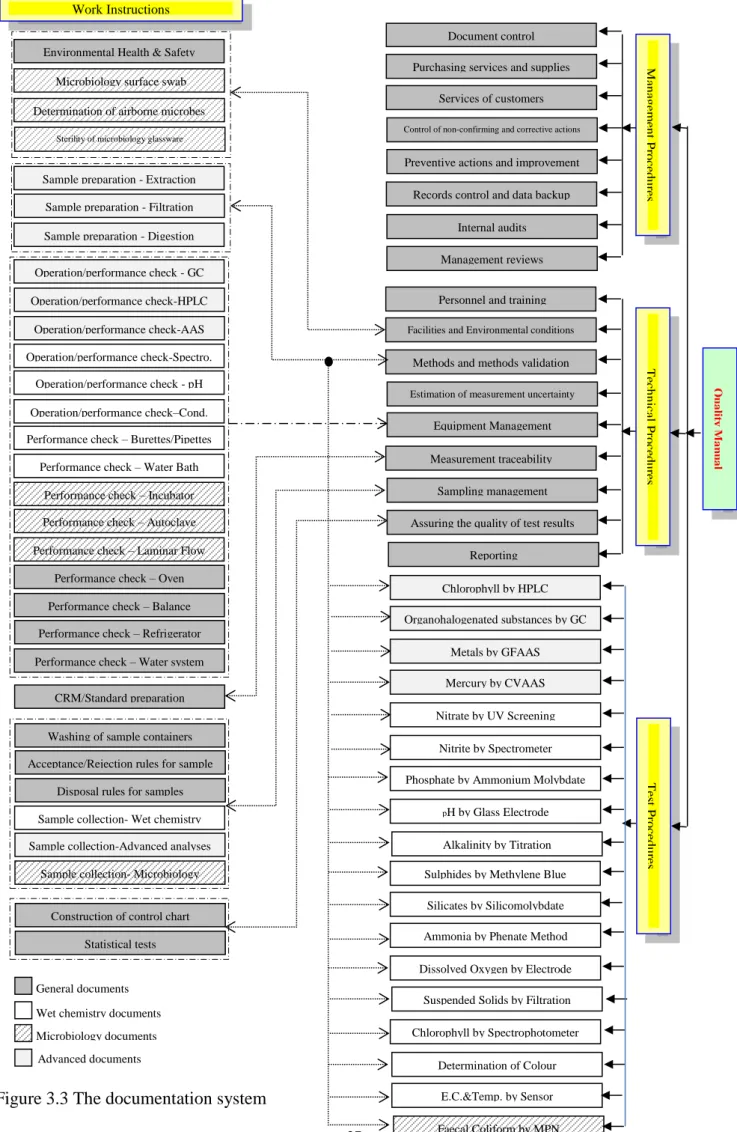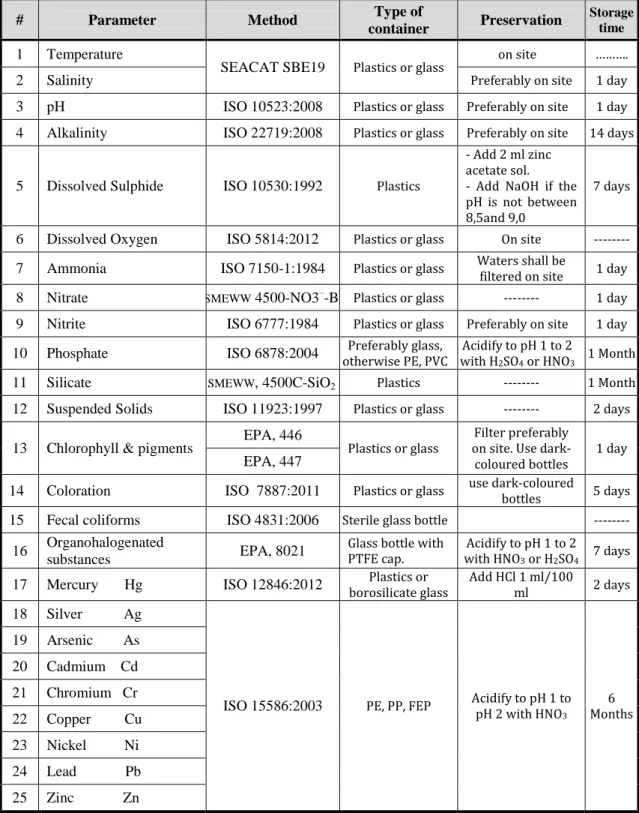UNIVERSIDADE DO ALGARVE UNIVERSITY OF ALGARVE
Design of a new laboratory for quality control of mussel produced in Sagres.
Saber Daoud Abdalla Elwany
Dissertação para a obtenção do grau de Mestre em Química Analítica Dissertation for obtaining a Master degree in Analytical Chemistry
Mestrado em Qualidade em Análises
(European Master in Quality in Analytical Laboratories)
Trabalho efetuado sob a orientação de: Work supervised by
Doutora Isabel Maria Palma Antunes Cavaco, University of Algarve, Faculty of Science and Technology and European Master in Quality in Analytical Laboratories (EMQAL). Doutor John Icely, University of Algarve, Centre for Marine and Environmental Research
(CIMA) and Sagremarisco - Viveiros de Marisco, Lda.
i
UNIVERSIDADE DO ALGARVE UNIVERSITY OF ALGARVE
Design of a new laboratory for quality control of mussel produced in Sagres.
Saber Daoud Abdalla Elwany
Dissertação para a obtenção do grau de Mestre em Química Analítica Dissertation for obtaining a Master degree in Analytical Chemistry
Mestrado em Qualidade em Análises
(European Master in Quality in Analytical Laboratory)
Trabalho efetuado sob a orientação de: Work supervised by
Assistant Professor. Isabel Cavaco, University of Algarve, Faculty of Science and Technology and European Master in Quality in Analytical Laboratories (EMQAL).
Dr. John Icely, University of Algarve, Centre for Marine and Environmental Research (CIMA) and Sagremarisco - Viveiros de Marisco, Lda.
ii
Design of a new laboratory for quality control of mussel produced in Sagres
Declaration of Authorship
I declare that I am the author of this work, which is original. The work cites other authors and works, which are adequately referred in the text and are listed in the bibliography.
Copyright: Saber Daoud Abdalla Elwany. The university of Algarve has the right to keep and publicise this work through printed copies in paper of digital form, or any other means of reproduction, to disseminate it in scientific repositories and to allow its copy and distribution with educational and/or research objectives, as long as they are non-commercial and give credit to the author and editor.
iii
Acknowledgements
My first and sincere appreciation goes to Isabel Cavaco, my senior supervisor for all I have learned from her and for her continuous help and support in all stages of this thesis. I would also like to thank her for being an open person to ideas, and for encouraging and helping me to shape my interest and ideas.
I would like to express my deep gratitude and respect to John Icely whose advices and insight was invaluable to me. For all I learned from him, and for providing the required information by contacting with Finisterra S.A. in Sagres.
In addition, I would like to thank Mr. Lourenço Ribeiro, for accessing the Finisterra Company to do our project.
I am really thankful to Management Team of European Master in Quality in Analytical Laboratory, EMQAL, for giving me this opportunity and supporting this work.
I’m also indebted to Mr Paulo Pedro, director of the laboratory of chemical analysis (LAQ), for his great effort during the cost analysis.
I’m grateful to my colleagues, Priscila Goela and Bruno Fragoso, for their help during this project.
I would like to thank my family, especially my mother and father for always believing in me, and my wife for her continuous love and her supports in my decisions. Without whom I could not have made it here.
I am also thankful to my son, Omar, for his patience. He always makes my life fun.
In the end, I want to thank all EMQAL members, the coordinator, the director, the professors and my colleagues for all I have learned from them.
iv Abstract
The growing demand for mussels globally has increased the competition among the producers. Production of high quality mussels demands quality controls in pre- and post-harvesting phases. The main concerns with the mussel industry relate to the pre-harvest stages where monitoring of pollution and management of production.
This present work deals with designing of a laboratory at the Finisterra’s aquaculture to control the environmental conditions on the production of mussels focusing on establishing of an efficient quality system. This quality system includes top management commitment, organizational structure and systematically extensive documentation system to comply with the management requirements of the international quality standards. Whilst, the technical part of our quality system covers the environmental conditions of the laboratory, traceability of the results through calibration and quality control activities, and investment in the laboratory personnel. Such quality system will allow the laboratory to be accredited according to ISO/IEC 17025:2005.
This project has been designed with enough flexibility for the Finisterra’s management to invest progressively. The base of the laboratory is wet chemistry unit which includes the routine work and preparation for the advanced analysis. Later, Finisterra can complete the work plan by investing in microbiological and advanced analysis.
The key benefits stemming from implementation of this quality system are improved competiveness and reliability, increased quality awareness and teamwork. Furthermore, the laboratory will gain the confidence of the clients, researchers and governmental institutions.
Cost analysis was conducted to estimate the initial and running cost of the quality system. The initial cost is insignificant in comparison to the total laboratory cost whereas running of the quality system increases the total running cost.
Keywords: Quality system, ISO/IEC 17025:2005, Laboratory design, Mussel aquaculture, Quality of shellfish water.
v
Contents
Title i
Declaration and copyright ii
Acknowledgement iii
Abstract iv
Index of contact v
List of abbreviations viii
1. Introduction 1
1.1. Mussel aquaculture 1
1.2. Laboratory and mussel aquaculture 3
1.3. Benefits of the quality system 4
2. Context 7
2.1. About Finisterra S.A. 7
2.2. Laboratory framework 11 3. Quality system 22 3.1. Organization 22 3.1.1. Laboratory’s structure 22 3.1.2 Quality policy 24 3.1.3 Documentation 25 3.2. Installation 28 3.2.1. Building considerations 28 3.2.2. Laboratory considerations 29 3.2.2.1 Laboratory layout 29
vi
3.2.2.3 Loss prevention, industrial hygiene and personnel safety 33
3.3. Equipment and Consumables 35
3.3.1 Selection of equipment 35
3.3.2 Requirements of the standard methods 35
3.3.2.1 Sampling requirements 36
3.3.2.2 Requirements for wet chemistry analyses 37
3.3.2.3 Microbiology requirements 42
3.3.2.4 Requirements for advanced analyses 43
3.3.3 Calibration and verification plan 46
3.4 Human Resources 49
3.4.1 Job analysis 49
3.4.2 Human resources planning 51
3.4.3 Orientation and Training 54
3.4.4 Performance appraisal 55
3.5 Quality control 56
3.5.1 Internal quality control 56
3.5.2 External quality control 58
4. Cost analysis 61
4.1 Introduction 61
4.2 Estimation of the quality system costs at Finisterra 63
5. Conclusions and Recommendations 67
6. References 69
6.1 Legislations and standards 76
6.2 Guides 76
vii List of abbreviations
AAS Atomic Absorption Spectroscopy
ADDIE Assess, Design, Develop, Implement and Evaluate BAP Best Aquaculture Practice
BC Before Christ
CCC Coastal Counter Current
CIPP Context, Input, Process, Product CIS Common Implementation Strategy
CVAAS Cold Vapour Atomic Absorption Spectroscopy DIN Dissolved Inorganic Nitrogen
DIP Dissolved Inorganic Phosphate
EC European Commission
EPA Environmental Protection Agency EQC External Quality Control
EU European Union
FAO Food and Agriculture Organization FEP Perfluoro(ethylene/propylene)
GC Gas Chromatography
GFAAS Graphite Furnace Atomic Absorption Spectroscopy HPLC High Performance Liquid Chromatography
HR Human Resource
HVAC Heating, Ventilating and Air Conditioning IEC International Electro-technical Commission
viii IPO Input, Process, Output, Outcome
IPQ Portuguese Institute for Quality - Insituto Português da Qualidade IQC Internal Quality Control
ISO International Organization for Standardization IUPAC International Union of Pure and Applied Chemistry
MPE Maximum Permissible Error
NA Not Available PE Polyethylene PP Polypropylene PT Proficiency Test PTFE Polytetrafluoroethylene PVC Poly(vinyl chloride) QC Quality Control QS Quality System
RECLARE Association of Accredited Laboratories in Portugal - Associação de Laboratórios Acreditados de Portugal
SMEWW Standard Methods for Examination of Water And Wastewater SPAs Special Protection Areas
SSTs Sea Surface Temperatures
SW South West
TVS Training Validation System
UV Ultra Violet
WFD Water Framework Directive WHO World Health Organization
1 1. Introduction
1.1 Mussel aquaculture
Mussel has been harvested for centuries. Blue mussel shells have been found in kitchen middens dated at 6000 B.C. Until the 19th century, mussels were harvested from wild beds in most European countries for food, fish bait and as a fertilizer. The initial step for mussel aquaculture was based upon storage and relaying fishery products. At the turn of the 1970s, traditional culture was improved by new technological developments using suspended rope culture, longlines (FAO, 2004-2014). Mussel farming is an easy, flexible and realistic measure and can be a cost-effective method to decrease the negative effects of eutrophication in marine waters (Gren et al., 2009). This positive feedback is an important mechanism in shallow ecosystems, that eventually stimulates primary production, hence bivalve food. Thus, mussels are cultured and harvested as a method of water quality management in some areas. Mussels can also be cultured in combination with fish farming, in integrated multitrophic aquaculture (IMTA), where shellfish and seaweed are harvested to compensate for nutrient enrichment through the metabolism of fish feed (European commission, 2012). Numerous of researchers have studied the values of mussel farming in combating the pollution produced through farming of salmon or other finfish (Stirling, 1995; Troell and Norberg, 1998; Whitmarsh et al., 2006;Handå et al., 2012) At the same time, mussel is healthy marine food that produced from a low level of the food chain, and nutrients are recycled from sea to land (Gren et al., 2009).
Marine water aquaculture accounted for about 29.2 percent of world aquaculture production by value in 2010. Global marine-water aquaculture production in 2010 is 18.3 million tonnes consists of marine molluscs (75.5%, 13.9 million tonnes), finfishes (18.7%, 3.4 million tonnes), marine crustaceans 3.8 % and other aquatic animals 2.1%. Figure 1.1 mentions the share of molluscs, mostly bivalves e.g. oysters, mussels, clams, cockles, arkshells and scallops, in the global aquaculture production during the last three decades. A significant part of the global production of marine molluscs, particularly in Europe and America, relies on the widely introduced Japanese carpet shell and Pacific cupped oyster. Moreover, China now produces large quantities of Atlantic bay scallop and Yesso scallop (FAO, 2012).
2
Among marine molluscs, mussels’ production is the third major species group in 2010 (FAO, 2012). In European Union, the production of molluscs and crustaceans accounted about 50 % of the total aquaculture production in 2009 where mussels are dominant among the other species (European commission, 2012).
Figure 1.1 World aquaculture production composition in marine water (FAO, 2012).
Three main types of mussel farming are practiced in the EU: shellfish rafts and longlines, intertidal and bottom shellfish culture (European Commission, 2012).
Shellfish rafts and longlines: Mussel and other shellfish aquaculture in deeper waters, through the use of suspended ropes and longlines from floating rafts, has developed to take advantage of spat fall locations as well as areas of good water quality and food availability. This form of aquaculture has become a particular feature of the Galician coastline of Spain, as well as south, west and northwest of Ireland and some Scottish lochs.
Inter-tidal shellfish culture is practiced extensively in the Western part of Europe and is one of the older, more traditional forms of aquaculture in the EU. It takes place within the intertidal area, thus benefiting from relatively accessible land-based support as well as the dynamic physical environment of the land/water interface.
Bottom shellfish culture is a form of shellfish culture where juvenile animals are placed or “re-layed” on a suitable substrate for on-growing. The substrate selected will depend upon the shellfish species being used – mussels and oysters prefer a hard or firm substrate whilst infaunal species such as clams prefer a softer substrate into which they can burrow. This form of aquaculture is often practised in shallow coastal or estuarine areas.
3
As regards the cultured species, mussels are the main species produced in the EU-27, with two species: the blue mussel Mytilus edulis and the Mediterranean mussel Mytilus galloprovencialis (European Commission, 2012).
1.2 Laboratory and mussel aquaculture
There is a growing demand for bivalves, not only in historically developed countries, but also in developing regions such as south-east and far-east Asia. The main concerns with the bivalve industry relate to the pre-harvest stages where monitoring of biotoxins, pollution and management of production areas remain problematical, with many producing countries failing to meet the strict requirements imposed by consuming nations. Assistance is needed in improving the pre- and post-harvest practices to produce satisfactory product quality and safety. Thus, the prospects for growing the bivalve industry in the world will depend on the ability to build reliable monitoring and inspection programmes and implement sustainable farming practices (WHO, 2010). Once the aquaculture sites have been identified for future exploitation or historically exist, the application of monitoring tools is a logical next step. Thus waters should be monitored for multiple contaminants in conjunction with shellfish flesh monitoring for those actual contaminants detected by water quality monitoring (WHO, 2010). A range of natural constituents and potential contaminants can effect on the cultivated mussels depending on the culture area and background water quality as stated in BAP standard. The effects of the pollutants on mussels have been studied, metals (Bebianno et al., 1995), PAHs (Cappello et al., 2013), copper oxide nanoparticles (Gomes et al., 2012), hexavalent chromium (Ciacci et al., 2012), organic compounds (Banni et al., 2010). Whilst Fernández et al (2012) studied the effects of the main marine pollutants, metals, PAHs, PCBs and DDTs in native mussels from the Mediterranean coast of Spain. Thus, the laboratory has played an important role in mussel aquaculture control by providing the management with the required information. The role of the laboratory is not only to detect the consequences of some pollutants in the aquaculture, but also to prevent some disasters to happen by implementing a quality monitoring program. This program is mentioned in details in regulation (EC) no. 113/2006 of the European Parliament and of the Council, of 12 December 2006. However, the results produced from the laboratory should be reliable, accurate and precise, particularly in case of assessment of compliance with predefined limits.
4 1.3 Benefits of the quality system
There will be costs in adopting a quality management system but there are compensating benefits (Prichard and Barwick, 2007). One of the biggest benefits of the quality system in analytical laboratory is producing reliable and traceable data. These data have mutual acceptance both nationally and internationally, by manufacturers, regulators, traders and governments (Prichard et al., 1995). Furthermore, accurate and precise results are extremely helpful tool for accepting or rejecting a product according to its specification (Prichard and Barwick, 2007). Hence, ISO/IEC 17025:2005 states that “where applicable information on uncertainty is needed in test reports when the uncertainty affects compliance to a specification limit”. Also, regulatory compliance often requires that a measurand, such as the concentration of a toxic substance, be shown to be within particular limits. Measurement uncertainty clearly has implications for interpretation of analytical results as shown in Figure 1.2. A decision rule that is currently widely used is that a result implies non-compliance with an upper limit if the measured value exceeds the limit by the expanded uncertainty. With this decision rule, then only case (i) in Figure 1.2 would imply non-compliance. Similarly, for a decision rule that a result implies compliance only if it is below the limit by the expanded uncertainty, only case (iv) would imply compliance. Another very simple decision rule is that a result equal to or above the upper limit implies noncompliance and a result below the limit implies compliance, provided that uncertainty is below a specified value. This is normally used where the uncertainty is so small compared with the limit that the risk of making a wrong decision is acceptable. To use such a rule without specifying the maximum permitted value of the uncertainty would mean that the probability of making a wrong decision would not be known (EURACHEM, 2007). In general the decision rules may be more complicated. They may include, for example, that for cases (ii) and (iii) in Figure 1.2, additional measurements should be made, or that manufactured product be compared with an alternative specification to decide on possible sale at a different price (EURACHEM, 2007).
5
Figure 1.2 Assessment of compliance with an upper limit (EURACHEM, 2007) On the other hand, producing wrong results has several social and economic impacts in different fields (Prichard and Barwick, 2007):
In trade, it could lead to the supply of sub-standard goods and the high cost of replacement with subsequent loss of customers.
In environmental monitoring, mistakes could lead to hazards being undetected or to the identification of unreal hazards.
These mistakes could cause huge costs, both in terms of financial and other resources, and in terms of the distress to individuals and their families. Moreover, such mistakes lead to loss of confidence in the analytical results. At one extreme, loss of confidence puts the future existence of the particular analytical laboratory at risk, but more generally it leads to costly repetition of analyses and, in the area of trade, inhibits the expansion of the world economy (Prichard and Barwick, 2007).
Another benefit of the quality system is the documentation system. Preparation of the documentation is time consuming process and it needs much effort as well. Nevertheless, it is the laboratory’s memory and a helpful tool that facilities the communication among different technicians for articulating common principles. In an established business consisting of many laboratories, each operating complex procedures, the more likely it is that misunderstandings and mistakes will have occured and been adopted even though they are bad practice. Even in small laboratories, the
6
absence of a member of staff who is on holiday or ill can cause confusion. If operating procedures are written down for staff to refer to, as part of the quality management system, the number of such mistakes will be reduced (Prichard and Barwick, 2007). Therefore, a further positive benefit for laboratories is that the customers of laboratories are increasingly asking for evidence that the laboratory’s results are reliable. The easiest way for customers to do this is to insist that an appropriate independent accreditation body accredits any laboratory tendering for their business (Prichard and Barwick, 2007). The benefits of laboratories’ accreditation with either ISO/IEC 17025 or ISO 15189 were studied in different countries, Greece (Vlachos et al., 2002), Spain (Bautista-Marín et al., 2012), Turkey (Yanikkaya-Demirel, 2009; Uras, 2009), UK (
Maynard,
2003
), Canada (Li and Adeli, 2009), Finland (Laitinen, 2009), China (Yang, 2009) and Netherlands (Slagter and Loeber, 2001). The conclusion of those studies is that accreditation of the laboratories increases the quality of the results, motivates the laboratory personnel and is beneficial for all interested bodies. Continuous improvement and dedicated people are the key elements for continuation of the quality assurance in an accredited laboratory. Furthermore, when a laboratory has established its quality management system and has had this assessed and accredited by an external accreditation body, the laboratory can use this recognition of their standards as a positive advertisement for their services (Prichard and Barwick, 2007). Finally, organizations that approach the accreditation process in terms of education and awareness can look forward to a collegial and productive encounter that can verify the high level of quality provided within an organization (Chapman, 2011).7 2. Context
2 .1 About Finisterra S.A.
According to work conducted at Finisterra S.A by Márcia Santos (2013), the Finisterra SA performs the cultivation of mussels (Mytilus spp. Trade name authorized in Portugal by P n. º587/2006 (I Série-B), de 22 de Junho) using a system of longlines, about 44 ha. This system is installed in the open sea, a mile and a half from the coast, south-west of mainland Portugal, facing the beaches Zavial and Ingrina, located in Sagres (Figure 2.1).
Under the terminology of the European Union (EU) Water Framework Directive (WFD), the Sagres area (SW Portugal) is classified as a mesotidal, moderately exposed Atlantic coastal type, characterized by a narrow continental shelf. It is one of the inter-calibration sites for the North East Atlantic used for the Common Implementation Strategy (CIS) of the WFD (Loureiro et al., 2008). The Sagres area is one of Special Protection Areas (SPAs) belongs to the Natura 2000 ecological network. The Natura 2000 Network aims to protect habitats and species of European interest that are rare or threatened. However it is not a system of strict nature reserves where all human activities are excluded. Instead, it supports the principle of sustainable development. Its aim is to ensure that, within these Natura 2000 sites, human activities, including aquaculture, are undertaken in a way that still allows the site’s conservation objectives to be reached (European Commission, 2012).
The Sagres area, off the south west coast of the Iberian Peninsula is affected by northerly winds from May to September (Loureiro et al., 2008). Moreover, this shelf is additionally affected by local westerly winds, that may also induce upwelling episodes, and influenced by the presence of a warm coastal counter current (CCC) originating in the Gulf of Cádiz, that may progress from the southern to the western platform of the peninsular, depending on pressure gradients and south-easterly wind forcing (Relvas and Barton, 2002).The dominance of north winds promotes the occurrence of upwelling events, transporting cold, nutrient rich waters, from the ocean bottom. During these periods, lower SSTs coincide with higher primary production, providing a good environment for culturing bivalves (Fragoso and Icely, 2009).
8
Por
tu
gal
Figure 2.1 Map of Sagres, Portugal: (A) Location of Finisterra longlines system, (B) Location of Finisterra laboratory.
The production system of Finisterra S.A. is featuring well offshore shellfish farming currently practiced in Portugal. This company produces mussels of the genus Mytilus extensively, using a longlines system, with a high potential for offshore aquaculture zone (Santos, 2013). A standard mussel longline consists of individual collectors or sleeves (or one continuous sleeve) suspended from a main line, which is maintained in a horizontal position using floats (Gosling, 2003). The longlines system in Finisterra consists of mounting system, moorings and cement weights 4 and 6 tons (Figure 2.2), and floating system, floating and mooring rafts (Figures 2.2 and 2.3). The suspended ropes are placed with a distance of 50 cm to 1 m from each other (Figure 2.2). In order to maximize the production, longlines of Finisterra S.A. are in an area where the depth varies between 20 m and 30 m and the used culture ropes extend between 2 m and 20 m deep approximately.
9
Figure 2.2 Scheme of longlines system used by Finisterra, (a) marker rafts, (b) floating rafts, (c) cement weights 6 tons, (d) cement weights 4 tons, (e) longlines, (f) culture ropes,(g) empty culture ropes for mussel juveniles’ growth, (h) culture ropes after mussel growth (Santos, 2013).
Figure 2.3 Different types of floating rafts used in Finisterra longlines system (Santos, 2013).
10
Juveniles are obtained by simply placing culture ropes, exploiting the natural recruitment in the production process, or collected from natural beds (approximately 5 mm) and fixed to the culture ropes (Figure 2.4a) using biodegradable network (Figure 2.4b). This network is degraded after approximately 10 days which are sufficient to allow attachment of mussels to culture ropes.
Figure 2.4 (a) culture ropes (b) biodegradable network, available from http://www.jjchicolino.es/catalogo.pdf. Accessed in 09 March 2014.
For maintenance of the longlines system and also to transport the mussels to land an adapted vessel for this work is used as mentioned in Figure 2.5.
Figure 2.5 Harvesting of mussel using a vessel at Finisterra (Santos, 2013).
11 2.2 Laboratory framework
Mussels are bivalve molluscs that feed by filtering a large volume of water and therefore have a capacity to bio-accumulate natural constituents and potential contaminants from the surrounding waters according to BAP standard. Suspended shellfish culture may also have an impact on the water column in both terms of dissolved oxygen levels as well as nutrients. However, the location of this type of system in areas with good water exchange and thus good dispersion of nutrients usually reduces the risk for such effects (European Commission, 2012). Hence, the protection and improvement of the environment necessitate concrete measures to protect waters, including shellfish waters, against pollution as stated in regulation (EC) no. 113/2006 of the European Parliament and of the Council, of 12 December 2006.
BAP standard describes the types of the contaminants affecting the mussel farm, “Many contaminants widely present in trace levels within the marine environment are unlikely to compromise product safety. Other contaminants can be elevated in certain areas due to continuous proximity to direct or indirect sources. Some areas with generally high water quality can be subject to periodic deterioration due to intermittent discharges, pollution spills or even natural events such as harmful algal blooms.” Therefore, the laboratory started designing a plan to monitor the water quality at Sagres, this plan consists of three main steps: specification of the monitoring parameters, characterization of the water at Sagres, methods selection. We have to discuss these three steps in details as follows:
1. Specification of the monitoring parameters
Regarding to regulation (EC) no. 113/2006 of the European Parliament and of the Council, of 12 December 2006., which concerns the quality of shellfish waters and applies to those coastal and brackish waters designated by the EC Member States as needing protection or improvement in order to support shellfish life and growth and thus to contribute to the high quality of shellfish products directly edible by man. The shellfish water quality monitoring programme of the previous directive is mentioned in Table 2.1. Moreover, these parameters are also mentioned by WHO in 2010 as the primary risk factors that affect the shellfish water quality. However, BAP standard recommended physical, chemical and biological parameters to protect both the mussel and the
12
environment in addition to other parameters to control the mussel production process such as food availability, phytoplankton, which has impacts on the growth and health of molluscs and other organisms.
13
Table 2.1 The monitoring program of quality of shellfish waters according to regulation (EC) no. 113/2006 of the European Parliament and of the Council, of 12 December 2006
# parameters G I Reference methods of analysis
Minimum sampling and measuring
frequency
1 pH 7-9
Electrometry
Measured in situ at the time of sampling
Quarterly
2 Temperature °C
A discharge affecting shellfish waters must not cause the temperature of the waters to exceed by more than 2 °C the temperature of waters not so affected
Thermometry
Measured in situ at the time of sampling
Quarterly
3 Coloration (after filtration) mg Pt/l
A discharge affecting shellfish waters must not cause the colour of the waters after filtration to deviate by more than 10 mg Pt/l from the colour of waters not so affected
Filter through a 0∙45 μm membrane Photometric method,
using the platinum/ cobalt scale
Quarterly
4 Suspended solids mg/l
A discharge affecting shellfish waters must not cause the suspended solid content of the waters to exceed by more than 30 % the content of waters not so affected
- Filtration through a 0∙45 μm membrane, drying at 105 °C and weighing
- Centrifuging (for at least five minutes, with mean acceleration 2 800 to 3 200 g), drying at 105 °C and weighing
Quarterly
5 Salinity ‰ 12 to 38 ‰
≤ 40 ‰ Discharge affecting shellfish waters must not cause their salinity to exceed by more than 10 % the salinityof waters not so affected
Conductimetry Monthly
6 Dissolved oxygen
(Saturation %) ≥ 80 %
≥ 70 % (average value) Should an individual measurement indicate a
value lower than 70 %, measurements shall be repeated An individual measurement
may not indicate a value of less than 60 % unless there are no harmful consequences for the development of shellfish colonies
- Winkler’s method - Electrochemical method
Monthly, with a
minimum of one sample representative of low oxygen conditions on the
day of sampling.
However, where major
daily variations are
suspected, a minimum of two samples in one day shall be taken
14 7 Petroleum
hydrocarbons
Hydrocarbons must not be present in the shellfish
water in such quantities as to:
— produce a visible film on the surface of the water and/or a deposit on the shellfish, — have harmful effects on the shellfish
Visual examination Quarterly
8 Organohalogenated substances
The concentration of each substance in shellfish flesh must be so limited that it contributes, in accordance with Article 1, to the high quality of shellfish products
The concentration of each substance in the shellfish water or in shellfish flesh must not reach or exceed a level which has harmful effects on the shellfish and larvae
Gas chromatograph after extraction
with suitable solvents and purification Half-yearly
9 Metals mg/ Silver Ag Arsenic As Cadmium Cd Chromium Cr Copper Cu Mercury Hg Nickel Ni Lead Pb Zinc Zn
The concentration of each substance in shellfish flesh must be so limited that it contributes in accordance with Article 1, to the high quality of shellfish products
The concentration of each substance in the shellfish water or in the shellfish flesh must not exceed a level which gives rise to
harmful effects on the shellfish and their larvae The synergic effects of these metals must be taken into consideration
Spectrometry of atomic absorption preceded, where appropriate, by concentration and/or extraction
Half-yearly
10 Faecal
coliforms/100 ml
≤ 300 in the shellfish flesh and intervalvular liquid
Method of dilution with fermentation in liquid substrates in at least three tubes in three dilutions. Subculturing of the positive tubes on a confirmation medium. Count according to MPN (most probable number). Incubation temperature 44 °C ± 0,5 °C
Quarterly
11
Substances affecting the taste of the shellfish
Concentration lower than that liable to impair the taste of the shellfish
Examination of the shellfish by tasting where the presence of one of these substances is presumed
12
Saxitoxin (produced by dinoflagellates)
15 2. Characterization of the water at Sagres
Before selecting the methods to analyse the monitoring program parameters, it is vital to know the concentration range of each parameter and the type of samples’ matrix. Sagres region is influenced by upwelling conditions producing change in the water characterization. The microalgal assemblage peaks during the active upwelling conditions whereas relaxation of upwelling is associated with low nutrient conditions (Loureiro et al., 2005). However, the upwelling introduces near the coast a large flux of comparatively trace metals-poor waters, which prevent the shelf waters from a further dispersal of the land-derived contaminants (Cotte-Krief et al., 2000). The available data were collected as shown in Table 2.2.
16 Table 2.2 Characterization of the water at Sagres
# Parameter Goela et al.,
2013 Santos-Echeandía et al., 2012 Loureiro et al., 2005 Cotte-Krief et. al., 2000 1 Temperature NA 12o C 14.6 - 17.0 o C NA 2 Salinity NA 33 – 35 35.8 – 35.9 36.27 – 36.28 3 pH NA NA NA NA 4 Alkalinity NA NA NA NA 5 Dissolved Sulphide NA NA NA NA 6 Dissolved Oxygen NA 5.5 mg/L 237 – 258 µM NA 7 Ammonia 0.55-15.5 µM (DIN) 0.5 – 4.0 µM 0.05 – 0.6 µM NA 8 Nitrate 4.3 – 19.3 µM NA 9 Nitrite 0.1 – 0.4 µM NA 10 Phosphate 0.03-0.40 µM (DIP) 0.1 - 0.5 µM 0.2 – 0.4 µM NA 11 Silicate NA 0.06 µM 0.1 – 2.4 µM NA 12 Suspended Solids NA NA NA NA
13 Chlorophyll & pigments NA NA NA NA
14 Coloration NA NA NA NA
15 Petroleum Hydrocarbons NA NA NA NA
16 Substances affecting the
taste of the shellfish NA NA NA NA
17 Fecal coliforms NA NA NA NA 18 Organohalogenated substances NA NA NA NA 19 Chlorophyll 0.1 - 2.31 µg/L 1.0 µg/L 1.2 – 6.2 µg/L NA 20 Silver Ag NA NA NA NA 21 Arsenic As NA NA NA NA 22 Cadmium Cd NA 0.15 – 0.25 nM NA 0.78 – 0.211 nM 23 Chromium Cr NA NA NA NA 24 Copper Cu NA 6.0 – 9.0 nM NA 3.7 – 12.2 nM 25 Mercury Hg NA < 8.0 pM NA NA 26 Nickel Ni NA < 3.0 nM NA 2.7 – 3.4 nM 27 Lead Pb NA < 0.03 nM NA 7.3 – 29.3 nM 28 Zinc Zn NA 10.0 – 15.0 nM NA NA
17 3. Methods selection
Proper method selection is critical to laboratory performance and must be mentioned under the quality system but in fact there is no simple, established formula (Garfield, 2000). The assessment process may involve a combination of efforts including a literature review, reference to personal experience or the experience of colleagues, consideration of what the instruments are available, the amount of time for analysis, the accuracy and precision required and similar considerations (Garfield, 2000). We established our own criteria to select the suitable methods:
Legal requirement to use a specific method.
One of the ISO/IEC 17025:2005 requirements is preference to select methods published in international, regional or national standards.
Preference to be given to methods that have been applied to the matrix of interest over methods that have been applied in other matrices.
Methods cover the concentration range of the interest with high accuracy, simple, low cost and rapid are chosen.
Table 2.3 mentions how we applied our criteria to select the suitable standard methods for each parameter.
According to these information, we specified all the parameters that related to environment protection and mussel production process including physical, chemical and microbiological parameters. The available data were used to characterize the water at Sagres and then the suitable standard methods were selected to fit the purpose of our work plan (Table 2.4).
18 Table 2.3 Selection of the suitable methods
Gr o u p # Parameter Standard methods
The selected standard/reasons
1st 2nd
Sam
p
lin
g
1 Planning ISO 5667-1:2006 --- ISO 5667-1:2006 Guidance on the design of sampling programmes and sampling techniques
2 Preservation ISO 5667-3:2012 --- ISO 5667-3:2012 Preservation and handling of water samples
3 Sampling ISO 5667-9:1992 --- ISO 5667-9:1992 Guidance on sampling from marine waters W et -ch em is tr y
1 Water for analytical
laboratory use ISO 3696:1987 --- ISO 3696:1987 Water for analytical laboratory use
2 pH ISO 10523:2008
Glass Electrode
ISO/CD 18191 M-cresol purple
ISO 10523:2008
Glass electrode method is fast, and environmental friendly
3 Alkalinity ISO 22719:2008
Potentiometric Titration ---
ISO 22719:2008 Determination of total alkalinity in sea water using high precision potentiometric titration. 4 Dissolved Sulphide
ISO 10530:1992
Photometric Method Using Methylene Blue
EPA 9034 Titrimetric Method
ISO 10530:1992
5 Dissolved Oxygen ISO 5813:1983 Winkler Method
ISO 5814:2012 Electrochemical Probe
ISO 5814:2012
Electrochemical probe is fast and environmental friendly.
6 Nitrate ISO 7890-3:1988
Reduction / Spectrometric Method
SMEWW 4500-NO3– - B UV Screening Method
SMEWW 4500-NO3– - B UV screening is fast and easy to work whereas reduction of NO3- by Cd/Cu
19 Gr o u p # Parameter Standard methods
The selected standard/reasons
1st 2nd W et -ch em is tr y 7 Nitrite ISO 6777:1984 Spectrometric Method ---
ISO 6777:1984 Determination of nitrite – Molecular absorption spectrometric method
8 Phosphate ISO 6878:2004
Spectrometric Method ---
ISO 6878:2004 Determination of phosphorus -- Ammonium molybdate spectrometric method
9 Silicate ISO 16264:2002
Automated Spectrometric Method
SMFWW, 4500C-SiO2
Manual Spectrometric Method
SMEWW, 4500C-SiO2 Molybdosilicate method is the
manual version of ISO 16264:2002.
10 Ammonia ISO 7150-1:1984
Manual Spectrometric Method
ISO 6778:1984 Ion Selective Electrode
ISO 7150-1:1984 Manual Spectrometric method is more sensitive than Ion Selective Electrode
11 Suspended solids ISO 11923:1997
Filtration / Drying ---
ISO 11923:1997 Determination of suspended solids by filtration through glass fibre filters.
12 Conductivity, Depth
and Temperature Manufacturer Manual --- Manufacturer manual of SEACAT SBE19 13 Chlorophyll SMEWW,10200H
Spectrometric Method
EPA, 446 Spectrometric Method
EPA, 446 In Vitro Determination of Chlorophylls a, b, c1 + c2 and Pheopigments in Marine And Freshwater
Algae by Visible Spectrophotometry
14 Coloration ISO 7887:2011 --- ISO 7887:2011 Examination and determination of colour.
15 Petroleum
Hydrocarbons Visual examination
---These methods are recommended by the directive 16 Substances affecting the
---20 Gr o u p # Parameter Standard methods
The selected standard/reasons
1st 2nd Mic ro b io lo g y
1 Faecal coliforms ISO 4831:2006 Most Probable Number
ISO 9308-1:2000
Membrane Filter ISO 4831:2006 MPN is recommended by the directive 2 Sampling ISO 19458:2006 --- ISO 19458:2006 Sampling for microbiological analysis
3 General requirements ISO 7218:2007
---ISO 7218:2007 Microbiology of food and animal feeding stuffs — General requirements and guidance for microbiological examinations
Ad v an ce d a n aly sis 1 Chlorophyll SMEWW,10200H HPLC method EPA, 447 HPLC method
EPA, 447 Determination of Chlorophylls a and b and Identification of Other Pigments of Interest in Marine and Freshwater Algae Using High Performance Liquid
Chromatography with Visible Wavelength Detection
2 Organohalogenated substances ISO 23631:2006 Using GC Or ISO 10301:1997 Using GC EPA, 8021 Using GC
EPA, 8021 is for determination of Organohalogenated substances generally whereas ISO 23631:2006 is limited to measure haloacetic acid and ISO 10301:1997 is for determination of highly volatile Organohalogenated substances. 3 Metals: Silver Ag Arsenic As Cadmium Cd Chromium Cr Copper Cu Mercury Hg Nickel Ni Lead Pb Zinc Zn ISO 15586:2003 Using GFAAS , ISO 12846:2012 Using CVAAS ---
ISO 15586:2003 includes principles and procedures for the determination of trace levels of: Ag, Al, As, Cd, Co, Cr, Cu, Fe, Mn, Mo, Ni, Pb, Sb, Se, Tl, V, and Zn. ISO 12846:2012 specifies two methods for the determination of mercury in water.
21
Table 2.4 The concentration range of monitoring parameters and the selected methods.
Group # Parameter Conc. range Method
Sampling 1 Planning ISO 5667-1:2006 2 Preservation ISO 5667-3:2012 3 Sampling ISO 5667-9:1992 Wet-chemistry
1 Water for analytical laboratory use ISO 3696:1987
2 Temperature 12 – 17 o C
Manufacturer Manual
3 Salinity 33 – 36 %
4 pH NA ISO 10523:2008
5 Alkalinity NA ISO 22719:2008
6 Dissolved Sulphide NA ISO 10530:1992
7 Dissolved Oxygen 5.5 mg/L ISO 5814:2012
8 Ammonia 0.05 – 0.6 µM ISO 7150-1:1984
9 Nitrate 0. 5 – 19.3 µM SMEWW 4500-NO3– -B
10 Nitrite 0.1 – 0.4 µM ISO 6777:1984
11 Phosphate 0.03 – 0.5 µM ISO 6878:2004
12 Silicate 0.06 – 2.4 µM SMEWW 4500-SiO2- C
13 Suspended solids NA ISO 11923:1997
14 Chlorophyll and pigments NA EPA, 446
15 Coloration NA ISO 7887:2011
16 Petroleum Hydrocarbons NA Visual Examination 17 Substances affecting the taste of the shellfish NA By Tasting
Microbiology
1 Faecal coliforms NA ISO 4831:2006
2 Sampling for microbiology ISO 19458:2006
3 General requirements for microbiology ISO 7218:2007Amd 1:2013
Advanced analysis
1 Chlorophyll 0.1 – 6.2 µg/L EPA, 447
2 Organohalogenated substances NA EPA, 8021B
3
Digestion of the metals ISO 15587-2
Mercury Hg < 8.0 pM ISO 12846:2012 Silver Ag NA ISO 15586:2003 Arsenic As NA Cadmium Cd 0.15 – 0.25 nM Chromium Cr NA Copper Cu 3.7 – 12.2 nM Nickel Ni 2.7 – 3.4 nM Lead Pb < 0.03-29.3 nM Zinc Zn 10.0 – 15.0 nM NA: Not Available
22 3. Quality System
3.1 Organization
Finisterra’s laboratory is a private laboratory of Portugal, offering quality services in water field to its internal and external customers.
3.1.1 Laboratory’s structure
Finisterra’s laboratory is specialized in performing standard analysis in water field in order to support research to ensure and improve the quality of the company’s product, mussel ssp. The laboratory is designed to perform all the parameters in the laboratory work plan as mentioned in Chapter 2. It is specialized in environmental monitoring and has ability to support related research projects by providing the infrastructures for chemical and water microbiological analysis under an accredited quality system. The system will ensure the reliability of results, recognition of the laboratory and confidence of the company form its clients, from the local government and from society in general. The laboratory consists of three basic units, customer services office and quality department:
Wet chemistry unit
This laboratory performs wide range of physical and chemical water analyses such as temperature, salinity, pH, alkalinity, dissolved oxygen, suspended solids, dissolved sulphides, ammonia, nitrite, nitrate, phosphate, coloration in addition to preparation of the samples for advanced analyses, digestion for AAS and CVAAS, filtration for HPLC, and extraction for GC determinations.
Microbiology unit
Faecal coliforms are detected in this laboratory, including preparation of the media.
Advanced analyses unit
This laboratory includes state of art equipment such as HPLC, GC, AAS and CVAAS.
Customer services office
The main activity of this office is to communicate with the internal and external customers.
Quality department
23
The laboratory has managerial and technical personnel who have the authority and resources needed to carry out their duties, including the implementation, maintenance and improvement of the quality system. The lines of authority for the laboratory management are shown in the organizational chart (Figure 3.1) , The technical and quality manager for the laboratory have the responsibilities with no conflicting interests may adversely influence the laboratory’s compliance with the requirements of the international standards.
Figure 3.1 Organizational chart of Finisterra’s laboratory Laboratory Director
Customer services Technical manager
Advanced lab. Technicians Wet-chemistry lab. Technicians Microbiological lab. Technicians Quality manager
24 3.1.2 Quality policy
Top management is committed to comply with the requirements of ISO/IEC 17025/2005, international standards and relevant legislations providing the integration of organizational structure, procedures and resources needed to fulfil the quality policy.
Mission
Our mission is twofold to fulfil the requirements of regulation (EC) no. 113/2006 of the European Parliament and of the Council, of 12 December 2006 on the quality required of shellfish water and to support research related to the continual improvement of the quality of mussel produced in the Sagres region.
Vision
The laboratory aims to support Finisterra to be one of the internationally leading companies in high quality mussel production, environmental monitoring and water researching field.
Statement and objectives
The commitment of top management is reflected in our laboratory’s mission and vision statements, as well as in the following quality objectives:
To continually monitor the effectiveness of the quality system through periodic internal audits and management reviews considering input from experts and interested parties;
To provide and maintain the highest reasonable standard of quality in all aspects of measurements.
Competent and qualified personnel are used to perform the tasks and are familiarized with the quality system documentation in order to implement the policies and procedures.
To ensure accurate and reliable results using the latest high-tech analytical equipment and best practice.
25 3.1.3 Documentation
Documentation is very important to ensure that the essential operations for the quality system work effectively and are performed with appropriate and updated documents. All those contributions to the laboratory activities are controlled according to procedures which guaranteed their verification, distribution and revisions. The clear, complete and correct documentation system is the laboratory’s credibility and the defensibility of its data (Garfield et al., 2000).
The quality system should be appropriate to the laboratory’s activates. Moreover, it should contain all documents, data and instructions to ensure that the work is in accordance with the requirements of ISO/IEC 17025:2005 and Portuguese accreditation body (IPAC). Figure 3.2 shows all the documents of our quality system mentioning the level of each document.
Figure 3.2 Hierarchy of the quality system documents
Records
Computer soft ware
Management Procedures
Technical Procedures.
Test Procedures
Quality Manual Level No. 1
Level No. 2
Level No. 3
Level No. 4
26
The main component of the documentation system is the quality manual that sets out the structure of the quality system. Whilst, management and technical documentation sets out how the quality system operates. Testing procedures and work instructions that members of staff have to follow to ensure the quality of results. Associated with the documentation system, a filing system including all the records and formats that the staff members fill during the daily activities. Hence, we designed a frame for the documentation system including all the main documents which the laboratory needs to comply with ISO/IEC 17025:2005. This documentation system includes a quality manual, 8 management procedures, 9 technical procedures, 18 testing procedures and 33 work instructions. The relationship among those documents is shown in Figure 3.3. During the writing phase of the documentation system, the laboratory may or not need to add or delete some documents. However, the final documentation system should be clear and complete. Also, that system shall be communicated to, understood by, available to, and implemented by the appropriate personnel as stated in ISO/IEC 17025:2005.
27 Tec h n ica l P ro ce d u re s M an ag em en t P ro ce d u re s Qu a lit y M a n u a l Document control Purchasing services and supplies
Services of customers Control of non-confirming and corrective actions
Preventive actions and improvement Records control and data backup
Internal audits Management reviews
Personnel and training Facilities and Environmental conditions
Methods and methods validation Estimation of measurement uncertainty
Equipment Management Measurement traceability Sampling management Assuring the quality of test results
Reporting Chlorophyll by HPLC Organohalogenated substances by GC Metals by GFAAS Mercury by CVAAS Nitrate by UV Screening Nitrite by Spectrometer Phosphate by Ammonium Molybdate
pH by Glass Electrode
Alkalinity by Titration Sulphides by Methylene Blue
Silicates by Silicomolybdate Ammonia by Phenate Method Dissolved Oxygen by Electrode
Suspended Solids by Filtration Chlorophyll by Spectrophotometer Determination of Colour E.C.&Temp. by Sensor Faecal Coliform by MPN Tes t P ro ce d u re s Work Instructions
Environmental Health & Safety Microbiology surface swab Determination of airborne microbes
Sterility of microbiology glassware
Sample preparation - Extraction Sample preparation - Filtration Sample preparation - Digestion Operation/performance check - GC Operation/performance check-HPLC Operation/performance check-AAS Operation/performance check-Spectro. Operation/performance check - pH Operation/performance check–Cond. Performance check – Burettes/Pipettes
Performance check – Water Bath Performance check – Incubator Performance check – Autoclave Performance check – Burettes/Pipettes Performance check – Laminar Flow
Performance check – Oven Performance check – Balance Performance check – Refrigerator Performance check – Burettes/Pipettes Performance check – Water system
CRM/Standard preparation Washing of sample containers Acceptance/Rejection rules for sample
Disposal rules for samples Sample collection- Wet chemistry Sample collection-Advanced analyses
Sample collection- Microbiology
Construction of control chart Statistical tests
Figure 3.3 The documentation system General documents
Wet chemistry documents Microbiology documents Advanced documents
28 3.2 Installation
Where a laboratory is purpose built, it will hopefully be designed in such a way as to minimise any expected problem (Prichard et al., 1995). There are several laboratory building design decisions that can significantly affect building and individual laboratory operating procedures, and make compliance with environmental health and safety regulations more likely and easier to attain (DiBerardinis et al, 2013).However, it can be very expensive to remove some of these problems and laboratory often involves a trade-off between cost and reducing the effects of the problems (Prichard et al., 1995). The laboratory design should be based on data collected from the laboratory management about the work activities, the number and types of the personnel and the interrelationship between the activities and the personnel (DiBerardinis et al, 2013). 3.2.1Building considerations
Finisterra has a plan to build a new building to extend its scope in mussel production activities. At this case, the laboratory will be a part of that building which has unrelated activities. Moreover, the company has a limited area for the laboratory which may be increased at a later time by converting non-laboratory areas such as offices into the laboratory. However, to do this safely, efficiently and cost effectively, advance planning is required to provide a latent reserve capacity to significantly increase the delivery of building systems used for heating, ventilating and air-conditioning, electrical services and piped utilities (DiBerardinis, 2013). Thus, some building considerations should be followed during the design phase to give the laboratory enough flexibility for upgrading. The building may include these space categories (DiBerardinis et al, 2013):
Laboratory is a category of net assignable area in which diverse mechanical services, special supplies and exhaust ventilation devices are available.
Laboratory support area is a category of net assignable area that contains the same services and ventilation facilities as the laboratory; it may adjoin the laboratory unit or may be elsewhere. This area includes glassware and sampling containers store, chemicals store, gas cylinders store, may or not glassware washing room.
Administration area is a category of net assignable area that contains only standard commercial electrical, telecommunication and office ventilation services.
29
This area includes the laboratory director office, secretarial pool, quality section and customer service office.
Personnel support area is a category of net usable area that is similar in function to administration areas but may contain added mechanical and HVAC services to provide for special needs. This area may include meeting room, toilets and dining facilities.
3.2.2 Laboratory considerations
Many health and safety requirements should be considered in the laboratory design regarding to the work activities. Finisterra work depends on two main disciplines, analytical chemistry and microbiology. The analytical chemistry activities include sample preparation involving digestion, extraction, distillation, mixing, heating, cooling and dilution. The main activity of the analytical laboratory is to analyse water samples using a variety of instruments and analytical techniques, HPLC, GC, AAS, CVAAS and spectrophotometer, some of which produce or utilize some hazardous materials, UV radiations, heating emissions and toxic fumes. Furthermore, hazardous materials always are used including small quantities of toxic chemicals, mineral acids, organic solvent, flammable and compressed gases. On the other hand, the microbiological activities include work with low-to-moderate risk biological agents (Biosafety Level 3). The equipment items found in this laboratory include laminar flow, autoclave, incubator, refrigerator and heating mantel.
3.2.2.1 Laboratory layout
The laboratory layout is critical for efficient use of space and the safety of laboratory personnel (DiBerardinis et al, 2013). Furthermore, ISO/IEC 17025:2005 states that there shall be effective separation between neighbouring areas in which there are incompatible activities. Regarding to these considerations we designed three separate layouts for the laboratory units, all of them have the same general safety considerations such as primary and emergency entry/egress, suitable aisles between benches, safety showers and eye washers, desks located away from the potential dangerous operations and enough work surface as well as some specific considerations for each layout as the following:
Wet chemistry layout (Figure 3.4a), which is designed to cover all the wet chemistry parameters in addition to sample preparation for the advanced
30 1. Primary Entry/Exit 2. Emergency Exit 3. Desk 4. Bench 5. Lab. Sink 6. Reagent Shelves 7. Fume hood 8. Balance
9. Water purification unit 10. Refrigerator
7 m
analysis. The most important consideration in this layout is safely locating of the chemical fume hoods required. During our design, we dedicated working zones for each activity to guarantee complete separation and to prevent cross contamination as mentioned in Figure 3.4b.
Advanced analysis layout (Figure 3.5), because HPLC, GC, AAS and CVAAS will be present in this laboratory, special care should be given to their locations relative to the ventilation system and egress routes. Access to the rear of bench mounted analytical instruments is very important for gas, and fluid lines, as well as for data transmission and power connections. Benches and countertops can be split and separated by a safe distance to allow one person at a time access to the back of those instruments (DiBerardinis et al, 2013).
Microbiology layout (Figure 3.6) is more likely to be a suite of rooms connected through central corridors. It should include washing facilities, sterilizing services and a space for donning and discarding protective garments at entry. In addition to the laboratory should contain class II biosafety cabinet for a single worker. Both the air supply and discharged must pass through HEPA filters for environmental protection. Walls and floors should be monolithic and made of washable and chemically resistant plastic, baked enamel, epoxy or polyester coatings (DiBerardinis et al, 2013).
Figure 3.4a Layout of wet chemistry laboratory 2 7 m 4 8 9 10 4 6 5 5 3 4 7 5 7
31
Figure 3.4b Layout of wet chemistry laboratory mentions the dedicated working zones • Zone A: Preparation of standards and samples for GC analyses
• Zone B: Preparation of standards and samples for HPLC analyses
• Zone C: Validation of the multi-sensors probe and calibration of dissolved Oxygen probe
• Zone D: Spectrophotometer working area for analysing Ammonia, Nitrate, Nitrite, Sulphide, Phosphate and Silicate .
• Zone E: Distillation for Ammonia.
• Zone F: Filtration for sulphide and suspended solids. • Zone G: Measurement of pH.
• Zone H: Titration cell for Alkalinity.
• Zone I: working area for dealing with the water purification system. • Zone J: working area for drying using the oven.
• Zone K: preparation of standards and samples. • Zone L: working area for weighing.
• Zone M: Data analysis • Zone N: Washing area.
1. Fume hood for working with organic solvents
32
Figure 3.5 Layout of advanced analysis laboratory 1. Primary Entry/Exit
2. Emergency Exit 3. Instrument racks 4. Bench
Figure 3.6 Layout of microbiology laboratory 4.5 m 5 m 3 3 7 4 3 5 4 2 1 6 5. Lab. sink 6. Desk 7. Electricity panel 1. Primary Entry/Exit 2. Emergency Exit
3. Entry/Exit for Washing Room 4. Anteroom
5. Clothes Changing Room 6. Washing Room 7. Working Room 8. Preparation Room 9. Wall bench 10. Lab. Sink 11. Autoclave 12. Media Refrigerator 13. Biosafety Cabinet 14. Pass-through Unit 15. Autoclave pass-through 3 m 2 m 2 m 2.5 m 1.5 m 2 m 1 2 3 4 5 6 7 8 9 9 10 11 12 13 14 15
33 3.2.2.2 Heating, ventilating and air conditioning
Laboratory facilities for testing, including but not limited to energy sources, lighting and environmental conditions, shall be such as to facilitate correct performance of the tests according to ISO/IEC 17025:2005. Well-designed and well-operated heating, ventilating, and air-conditioning (HVAC) systems are essential for laboratory health and safety protection, as well as for an environment that promotes comfort, productivity, and good work practices (DiBerardinis et al, 2013). During the design, some considerations should be given to these critical aspects:
Temperature control: Heating and air-conditioning systems must provide the uniform temperature that is required for the efficient operation of many analytical devices. Some instruments produce heat such as GC, AAS and heating mantels, thus each of the analytical instruments and auxiliary equipment should be evaluated when estimating heating and air-conditioning requirements.
Laboratory Ventilation System: A replacement system is enough for the laboratory; the air conditioning system replaces the volume of air discharged to the atmosphere through the health and safety exhaust ventilation system. However, special consideration should be given to providing good coverage for the advanced analysis laboratory and media preparation room using local exhaust systems to control odours some toxic fumes at the source. Moreover, digestion procedures and such operations must be performed in the fume hood. 3.2.2.3 Loss prevention, industrial hygiene and personnel safety
Many laboratories have good designs but at the same time they suffer much from unforeseen events. Therefore, the best design which contains all the possible emergencies and safety services.
Emergencies: Many emergencies should be covered by the laboratory design such as emergency fuel gas shutoff, ground fault current interrupters and master disconnect switch, emergency shower and eye wash. In addition to emergency cabinet which includes fire blanket, fire extinguisher, first aid kit, protective clothing, flash light and chemical/biological spill kit.
Safety: Safety considerations should include alarm system, equipment safety and personnel safety.
34
Chemical and biological disposal: Discarded hazardous materials, including flammable liquids, biological waste and highly toxic chemicals should be segregated in specific areas within the laboratory for disposal.
35 3.3 Equipment and Consumables
3.3.1 Selection of equipment
Performance of equipment varies from manufacturer to manufacturer to fulfil the market’s needs in different prices. However, equipment and its software used for testing and sampling shall be capable of achieving the accuracy required and shall comply with specifications relevant to the tests concerned as stated in ISO/IEC 17025:2005. Performance and cost are crucial issue for equipment’s purchasing but with other considerations:
The work load volume
The laboratory space
Ruggedness needed not only to work in or with highly salty samples but also to locate the equipment in environment influenced by the sea.
The manufacturer should have technical support agent in Portugal to guarantee the prompt availability for repairs.
Some analytical equipment should be evaluated before purchasing by furnishing the equipment in temporary basis in the laboratory or demonstration in another laboratory.
3.3.2 Requirements of the standard methods
ISO/IEC 17025:2005 states that the laboratory shall be furnished with all items of sampling, measurement and test equipment required for the correct performance of the tests (including sampling, samples preparation, processing and analysis of test data). All the requirements of the standard methods were collected and listed under four main disciplines as follows:
Sampling requirements
Requirements for wet chemistry analyses
Requirements for advanced analyses
Microbiology requirements
Each discipline has the related parameter (s) to be analysed, the requirements listed for each parameter separately. Using this way is to avoid missing any equipment or consumable but another list will prepare for purchasing to avoid repetition of any requirement as will mention in Chapter 4.
36 3.3.2.1 Sampling requirements
These requirements have been collected from ISO 5667-3:2012 for chemical parameters and ISO 19458:2006 for microbiological parameter. Then, the non ISO standards were checked for additional requirements. Table 3.1 shows the equipment and consumables required for sampling for each parameter.
Table 3.1The equipment and consumables for sampling
# Parameter Method Type of
container Preservation
Storage time
1 Temperature
SEACAT SBE19 Plastics or glass on site ……….
2 Salinity Preferably on site 1 day
3 pH ISO 10523:2008 Plastics or glass Preferably on site 1 day 4 Alkalinity ISO 22719:2008 Plastics or glass Preferably on site 14 days 5 Dissolved Sulphide ISO 10530:1992 Plastics
- Add 2 ml zinc acetate sol. - Add NaOH if the pH is not between 8,5and 9,0
7 days
6 Dissolved Oxygen ISO 5814:2012 Plastics or glass On site --- 7 Ammonia ISO 7150-1:1984 Plastics or glass Waters shall be filtered on site 1 day 8 Nitrate SMEWW 4500-NO3–-B Plastics or glass --- 1 day
9 Nitrite ISO 6777:1984 Plastics or glass Preferably on site 1 day 10 Phosphate ISO 6878:2004 otherwise PE, PVC Preferably glass, with HAcidify to pH 1 to 2
2SO4 or HNO3 1 Month
11 Silicate SMEWW, 4500C-SiO2 Plastics --- 1 Month
12 Suspended Solids ISO 11923:1997 Plastics or glass --- 2 days 13 Chlorophyll & pigments EPA, 446 Plastics or glass
Filter preferably on site. Use
dark-coloured bottles 1 day
EPA, 447
14 Coloration ISO 7887:2011 Plastics or glass use dark-coloured bottles 5 days
15 Fecal coliforms ISO 4831:2006 Sterile glass bottle --- 16 Organohalogenated
substances EPA, 8021
Glass bottle with
PTFE cap. with HNOAcidify to pH 1 to 2 3 or H2SO4 7 days
17 Mercury Hg ISO 12846:2012 borosilicate glass Plastics or Add HCl 1 ml/100 ml 2 days 18 Silver Ag
ISO 15586:2003 PE, PP, FEP Acidify to pH 1 to pH 2 with HNO
3 6 Months 19 Arsenic As 20 Cadmium Cd 21 Chromium Cr 22 Copper Cu 23 Nickel Ni 24 Lead Pb 25 Zinc Zn
